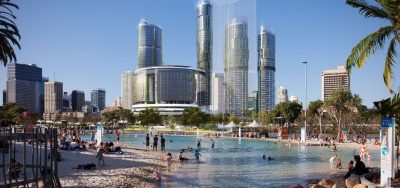Operator News
Australia – Economic Development Queensland approves Queens Wharf plan
By Phil - 4 January 2018
Economic Development Queensland has approved the plan of development application for the US$3bn Queens Wharf Brisbane casino resort proposal from the Destination Brisbane Consortium, of which Star Entertainment Group is a part of.
The Queen’s Wharf site was officially passed over to the Destination Brisbane Consortium on January 1.
State Development Minister Anthony Lynham said construction would create 2,000 jobs, with 8,000 jobs expected once it is finished.
“It’s a very exciting day, the most exciting day for 2017 so far, that’s for sure,” he said. “Every city has an iconic landmark that people look at, you can imagine people visiting Brisbane, standing out there at South Bank looking at this magnificent structure from South Bank. It’s an architectural gem, the way the skydeck comes around, and the thing I most like about it, as the minister, is there’s 12 football fields of public space.”
Queen’s Wharf is scheduled to open in 2022 with casino gaming facilities, 1,000 new hotel rooms, 50 new bars and restaurants, retail space, a free and accessible skydeck 100m above William Street, 2,000 apartments and a new pedestrian bridge to South Bank.
Star Entertainment Group Chief Executive Officer Matt Bekier said the first works would involve securing nine heritage buildings on the site.
“They’ll be braced and sheltered to make sure that during the construction work they can’t be damaged, then the actual demolition work will commence,” Mr Bekier said. “This is not an easy job because there’s so much traffic all around us, there’s so many people moving around, and because of the heritage buildings, and to safeguard the workers. It’s almost a brick-by-brick demolition job.”
The approved plan will guide the development of a former government precinct in Brisbane into an “integrated resort” with a casino, five hotels, 50 bars and restaurants, 2,000 apartment, retail spaces an the adaptive reuse of existing heritage-listed government buildings.
The masterplan development will occupy 12 hectares existing state-owned land, and proposes to reclaim potentially 15.3 hectares of the Brisbane River. In total, the approved development area will cover 27.3 hectares, making it the largest private development in Queensland, equivalent to 20 percent of the city centre.
The site marks the place where Brisbane’s colonial history began and has been described as the city’s “oldest and most symbolic precinct” by the Australian Institute of Architect’s national president Richard Kirk (formerly Queensland chapter president). The Queensland Parliament House is located directly adjacent to the proposed casino resort precinct.
The area includes 13 existing buildings, eight of which are heritage-listed and will be retained and four have been or will be demolished, including the Neville Bonner Building designed by Davenport Campbell and Partners in association with Donovan Hill and Powell Dods and Thorpe, which received the FDG Stanley Award for Public Architecture at the 1999 Queensland Architecture Awards.
Also approved is a pedestrian bridge designed by Grimshaw Architect which will connect the casino resort precinct to the existing South Bank Parklands on the opposite side of the Brisbane River. Likewise, the development area will be home to a number of new buildings including towers up to 74 storeys (265 metres) tall.
The plan of development application had been assessed by a range of government organizations and departments including Brisbane City Council, the Department of Transport and Main Roads, South Bank Corporation, the Department of Environment and Heritage protection, the Queensland Heritage Council, the Queensland Urban Design and Places Panel and the Queensland Government Architect.
However, the development has been heavily criticized by peak built environment groups, including the Australian Institute of Architects, Australian Institute of Landscape Architects and the Urban Design Alliance, which questioned the appropriateness of locating a casino so close to the seat of government. Former Queensland government architect Michael Keniger told ArchitectureAU in 2015, “It’s unfortunate that such a large scale development driven by the needs of the gaming floor of the casino overrides what was a coherent government precinct and overrides its setting.”
The project’s design partners include Jerde Partnership (lead design in masterplan, urban design and place-making), Cottee Parker (integrated resort development architects), ML Design (heritage architects), Grimshaw (bridge architects), Urbis (landscape architects, heritage specialists, town planners and urban designers) and Cusp (landscape architects).
Demolition of the existing non-heritage buildings began in 2017. The approval of the plan of development will allow new works to begin in 2018.
Queen’s Wharf Brisbane was declared a priority development area in November 2014 and in July 2015, the government named the Destination Brisbane Consortium as its preferred proponent for the site.
Probuild has been named as the successful tenderer for the project.
Destination Brisbane Consortium Project Director Simon Crooks said the decision was made following a competitive tender process and a rigorous assessment period.
“Probuild is a national company with experience in delivering some of the state’s largest construction projects,” he said “We have now worked with them first hand through the demolition work they are currently undertaking and have confidence in their ability to seamlessly execute on the excavation works package.
“Probuild has been diligent in ensuring stringent safety standards are maintained across the site and has worked to minimise disruption for Brisbane commuters, cyclists, pedestrians and inner-city residents, which are key priorities for our Consortium.”
Mr Crooks said the scale of excavation for the site was unprecedented for a Queensland city centre.
“In total more than 450,000m3 of materials will be removed to make way for the future Queen’s Wharf Brisbane integrated resort development basement,” he said. “This will be the largest city-based excavation project to occur in Queensland.”


